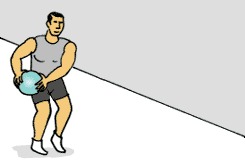
Muscle Cramps
Training Newsletter
- Smart Video tips
- See the latest sports products
- Secret special Members Only sales!
 |
Muscle Cramps
|
Subscribe to the JumpUSA Smart
Training Newsletter
|
|
Looking for something in particular? Enter your keyword here: Click
on
your sport to see what we have to improve your game:
|
JumpUSA.com Topic #472
Muscle
Cramps: 5 Simple Remedies
A cramp is an involuntary and forcibly contracted muscle
that does not relax. Cramps can affect any muscle under your voluntary
control (skeletal muscle). Muscles that span two joints are most prone
to cramping. Cramps can involve part or all of a muscle, or several
muscles in a group. The most commonly affected muscle groups are:
Cramps in the feet, hands, arms, abdomen and along the rib cage are also very common. Muscle cramps range in intensity from a slight tic to agonizing pain. A cramping muscle may feel hard to the touch and/or appear visibly distorted or twitch beneath the skin. A cramp can last a few seconds to 15 minutes or longer. It might recur multiple times before it goes away. CONTINUED BELOW (Muscle Cramps: see below for Why Cramps Happen and Treatment and Prevention) Sport Specific
Training Exercise of the week - Increase your 'rotational
power' with the explosive side throw. A great exercise for athletes
needing more hip power for sports like baseball, tennis, hockey and
golf!
Explosive Side Throws -
Stand sideways approximately 5 feet from sturdy wall. Hold the ball at
hip level and and explosively throw the medicine ball towards the wall.
Try to let your abs and core do most of the work. Catch the ball and
repeat for desired repetitiions. Repeat on other site.
Increasing distance from the wall will increase intensity.  For Sport Specific Tips
that will help you improve and excel in your sport, visit SportSpecific.com
For Bouncing Medicine Balls,
go here.
(Muscle Cramps: continued from above) Why Cramps Happen Although the exact cause of muscle cramps is unknown (idiopathic), some researchers believe inadequate stretching and muscle fatigue leads to abnormalities in mechanisms that control muscle contraction. Other factors may also be involved, including exercising or working in intense heat, dehydration and depletion of salt and minerals (electrolytes). Stretching & Muscle Fatigue:
Heat, Dehydration &
Electrolyte Depletion: Treatment & Prevention

Cramps usually go away on their own without seeing a doctor. For Self-Care:
To avoid future cramps, work toward better overall fitness. Do regular flexibility exercises before and after you work out to stretch muscle groups most prone to cramping. Always warm up before stretching. Calf Muscle Stretch: Hamstring Muscle Stretch: Quadriceps Muscle Stretch: Hold each stretch briefly, then release. Never stretch to the point of pain. To prevent cramps, you should also keep your body adequately hydrated. Children especially often do not drink enough liquids to replenish fluid lost during exercise. Some tips:
(Galanis,
bodybuilding.com)
1.Medline
Plus “Muscle Cramp, March 2001.
2.Medicine
Net “Muscle Cramps (Of skeletal muscles), 1990.
3.Arch
Intern Med “Muscle Cramps, 1990.
4.Better
Bodz “Muscle Cramps, May 2003.
|